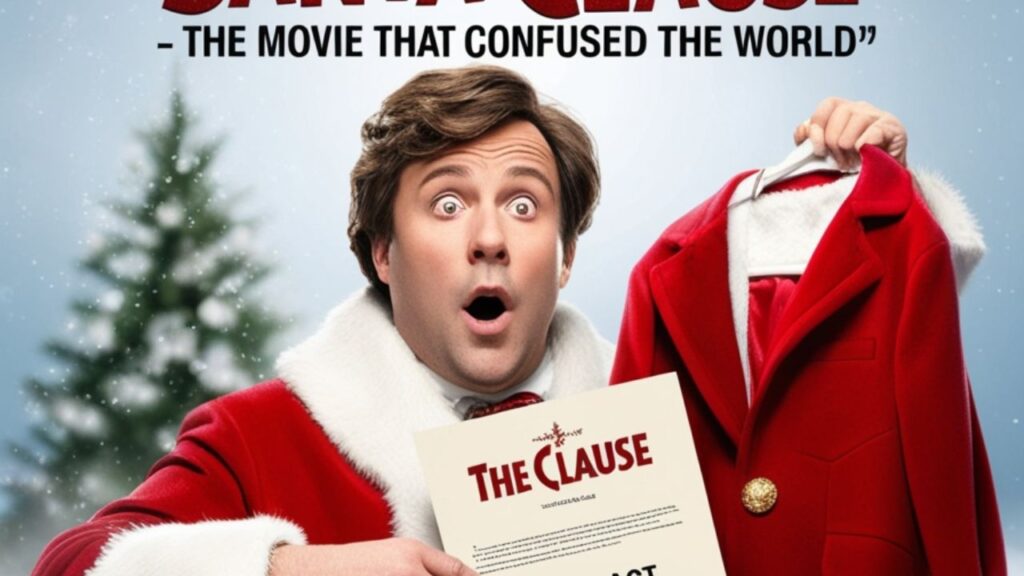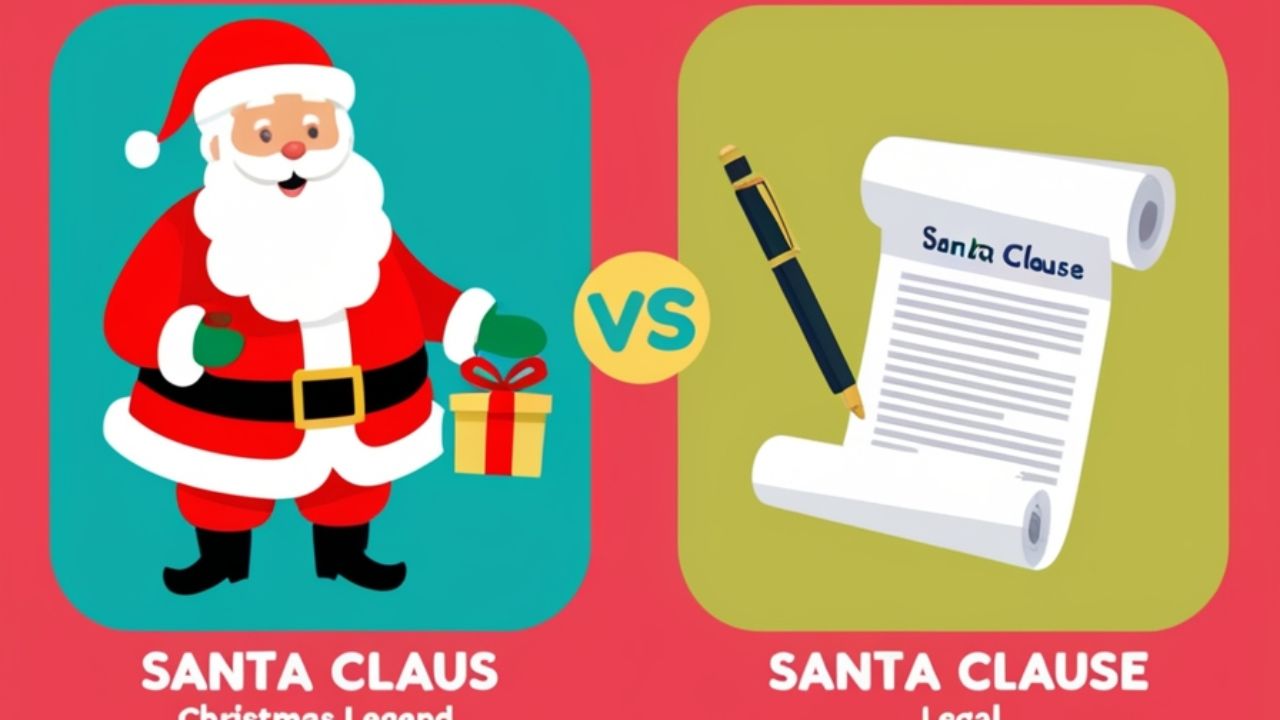Santa Claus brings joy to children every Christmas. He wears a red suit, rides a sleigh, and gives gifts to good kids. His name comes from old stories about Saint Nicholas, a kind man who helped the poor and gave gifts in secret.
Many people mistakenly write Santa Clause, but that word means a part of a legal document. The confusion started when a movie called The Santa Clause became famous. It made people think both spellings were right, but only one truly is.
Always remember, Santa Claus is the cheerful man who spreads happiness, not a rule in a paper. Using the correct spelling keeps stories and traditions alive and helps everyone learn the real history of the Christmas spirit.
Santa Claus vs. Santa Clause – What’s the Real Name?
Santa Claus is the happy man who gives presents on Christmas Eve. He wears red clothes, has a big white beard, and rides a sleigh with reindeer. His name came from Saint Nicholas, a kind man who loved sharing and helping others.
Many people write Santa Clause, but that is not right. The word “Clause” means a rule in writing or law. A movie used this spelling as a joke, and that made people confused about which one is correct.
- Santa Claus is the kind man who gives gifts on Christmas. His name came from old stories about Saint Nicholas, known for helping poor people and spreading love.
- Santa Clause is not the real name. It came from a movie that used a funny play on words, making many people write it by mistake.
- The true spelling is Santa Claus, not the one with an “e.” Using the right name keeps the story and the Christmas spirit real and full of joy.
The Real Origins of Santa Claus: From Saint to Symbol
Santa Claus is more than just a holiday character – he’s a blend of religious tradition, folklore, and cultural evolution.
Where it all began: Saint Nicholas
- Saint Nicholas was a kind man who lived a long time ago and helped poor people by giving them food, money, and gifts in secret.
- He became famous for his love, care, and generosity toward children and families in need.
- Over many years, stories about Saint Nicholas spread around the world, and he later became known as Santa Claus, the symbol of giving and joy.
From Nicholas to Claus
- The name Claus came from the Dutch word Sinterklaas, which means Saint Nicholas. Dutch people shared stories about him when they moved to new lands.
- As time passed, people changed Sinterklaas into Santa Claus to make it easier to say in English.
- The name Santa Claus grew popular in America and became the name everyone used for the cheerful man who brings gifts on Christmas.
See also Raise Cain Meaning & Usage: A Classic Idiom Explained
The Dutch Influence: Sinterklaas to Santa Claus

- The Dutch people played a big part in shaping Santa Claus. They brought the story of Sinterklaas, a kind man who gave gifts to children, when they moved to new places like America.
- Over time, the name Sinterklaas slowly changed into Santa Claus because English speakers found it easier to say.
- Dutch traditions, like gift-giving and red clothing, became part of Christmas celebrations everywhere, helping create the joyful image of Santa Claus known today.
Global Variations of Santa’s Name
| Country | Local Name | Translation | Notes |
| Netherlands | Sinterklaas | Saint Nicholas | Celebrated on Dec 5 |
| France | Père Noël | Father Christmas | Wears a long red robe |
| Germany | Weihnachtsmann | Christmas Man | Brings gifts on Dec 24 |
| Russia | Ded Moroz | Grandfather Frost | Accompanied by Snegurochka (Snow Maiden) |
| Italy | Babbo Natale | Daddy Christmas | Influenced by both Santa and local folklore |
| UK | Father Christmas | – | Sometimes used interchangeably with Santa |
The Santa Clause Effect: How a Movie Created Global Confusion
If you’ve ever typed “Santa Clause” and second-guessed yourself, you’re not alone.
What Is The Santa Clause?
- The Santa Clause is a popular Christmas movie that came out in 1994. It tells the story of a man who accidentally becomes Santa after finding a magical suit.
- The word “Clause” in the title means a rule in a contract, not a name. The movie used it as a funny play on words.
- Because of the film, many people started spelling Santa Claus the wrong way, thinking “Clause” was correct when it was only used as a movie joke.
Case Study: Google Trends
In December, searches for “Santa Clause” spike worldwide – especially among Gen Z and Millennials who grew up with the movie.
Impact of the Film:
The movie The Santa Clause made many people think the spelling with an “e” was correct. It showed a funny story about a man who becomes Santa because of a magic rule. This idea made children and adults enjoy the holiday even more.
After the film, shops and toys started using The Santa Clause spelling everywhere. People saw it on posters, cards, and gifts. Over time, the movie changed how some people wrote the name, even though only one spelling is truly right.
| Word | Part of Speech | Meaning | Example |
| Claus | Proper noun | Short for Nicholas; used in names | Santa Claus is coming to town. |
| Clause | Common noun | A grammatical or legal statement | The contract includes a new clause. |
Claus = Person
It’s used in names: Santa Claus, Klaus, Claus von Stauffenberg
Clause = Condition
It’s used in documents: “The non-compete clause will last two years.”
Key takeaway:
Santa is a Claus, not a clause. One’s a guy with a sleigh. The other is legal jargon.
Claus as a Real-Life Surname
The name Claus isn’t just a mythical one – it’s a common Germanic surname and first name.
Notable Individuals:
- Claus von Stauffenberg was a brave German officer who tried to stop Adolf Hitler during World War II. His courage made him a symbol of resistance and honor.
- Claus Helmut Drese was a famous Austrian theater director known for his creative work in European performing arts.
- Many people across Germany, Denmark, and the Netherlands have the name Claus, showing its deep roots in European history and culture.
See also By Which or In Which: Grammar Rules & Easy Examples
Common Misspellings and Internet Confusion

The digital world doesn’t help the situation. In fact, it makes it worse.
Misspelling Traps:
- Many people type Santa Clause instead of Santa Claus because the movie made the wrong spelling look familiar and fun.
- Online shops and ads often use the wrong version by mistake, which spreads more confusion during the holidays.
- Search engines and social media sometimes autocorrect or suggest Santa Clause, making it harder for people to remember the right spelling.
Final Thoughts
The real name is Santa Claus, the joyful man who brings gifts and happiness at Christmas. His name has a long history that started from Saint Nicholas, a kind man known for giving and caring for others in secret.
The movie The Santa Clause made people mix up the spelling, but learning the right one keeps the story true. Knowing the difference helps children remember the real holiday spirit filled with kindness, love, and sharing.
FAQs
Is it spelled Santa Claus or Santa Clause?
The correct spelling is “Santa Claus.” “Santa Clause” is incorrect unless referring to the movie The Santa Clause.
Why is Santa Claus called Santa Clause?
“Santa Clause” is a mistaken spelling; “Claus” comes from the Dutch “Sinterklaas,” meaning Saint Nicholas.
How do you spell Santa Claus in English?
It’s spelled “Santa Claus” — with “Claus,” not “Clause.”
Is there an E in Santa Clause?
No, not in the real name. The “E” only appears in the movie title The Santa Clause.

Join Bibcia on a journey to master English grammar. Discover easy lessons, writing tips, and practical examples designed to make learning grammar simple and effective.










